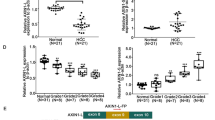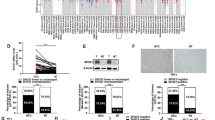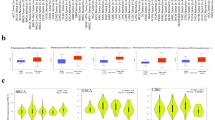Abstract
Background
The human cervical cancer oncogene HCCR-2 is overexpressed in various malignant tumors and cell lines, and might function as a negative regulator of the p53 tumor suppressor. Here, we used RNA interference strategies to evaluate the role of HCCR-2 in liver cancer, and to explore its potential therapeutic effect.
Methods
Changes of HepG2 cells stably transfected by an HCCR-2 RNA interference vector were detected by real-time PCR, MTT staining, plate colony formation, flow cytometry, and cell migration experiments. Apoptosis-related protein Bcl-2 and Bax levels were measured by Western blot.
Results
Our results showed that of the three siRNA-expressing vectors, siRNA-H3 had a suppressive effect on the expression of HCCR-2 mRNA, interfering with proliferation and migration of HCCR-2. Moreover, the apoptotic rate also increased, and cells transfected by siRNA-H3 were blocked in the G0/G1 stage. Plate colony formation experiments demonstrated that the single cell clone formation capacity of HepG2-H3 cells was clearly lower than that of HepG2 and HepG2-N cells. Western blot results indicated that the expression of Bcl-2 was inhibited, and the expression of Bax was increased.
Conclusions
In summary, RNAi targeting HCCR-2 could be an effective means for suppressing malignant features of hepatocellular carcinoma cells.




Similar content being viewed by others
References
Parkin DM, Bray F, Ferlay J, Pisani P. Estimating the world cancer burden: Globocan 2000. Int J Cancer 2001;94(2):153–156.
Llovet JM, Burroughs A, Bruix J. Hepatocellular carcinoma. Lancet 2003;362(9399):1907–1917.
Altekruse SF, McGlynn KA, Reichman ME. Hepatocellular carcinoma incidence, mortality, and survival trends in the United States from 1975 to 2005. J Clin Oncol 2009;27(9):1485–1491.
Poon D, Anderson BO, Chen LT, Tanaka K, Lau WY, Van Cutsem E, Singh H, Chow WC, Ooi LL, Chow P, Khin MW, Koo WH; Asian Oncology Summit. Management of hepatocellular carcinoma in Asia: consensus statement from the Asian Oncology Summit 2009. Lancet Oncol 2009;10(11):1111–1118.
Blum HE. Hepatocellular carcinoma: therapy and prevention. World J Gastroenterol 2005;11(47):7391–7400.
Schwartz MA. Integrins, oncogenes, and anchorage independence. J Cell Biol 1997;139(3):575–578.
Frisch SM, Ruoslahti E. Integrins and anoikis. Curr Opin Cell Biol 1997;9(5):701–706.
Douma S, Van Laar T, Zevenhoven J, Meuwissen R, Van Garderen E, Peeper DS. Suppression of anoikis and induction of metastasis by the neurotrophic receptor TrkB. Nature 2004;430(7003):1034–1039.
Wewer UM, Shaw LM, Albrechtsen R, Mercurio AM. The integrin alpha 6 beta 1 promotes the survival of metastatic human breast carcinoma cells in mice. Am J Pathol 1997;151(5):1191–1198.
Smit MA, Geiger TR, Song JY, Gitelman I, Peeper DS. A Twist-Snail axis critical for TrkB-induced epithelial-mesenchymal transition-like transformation, anoikis resistance, and metastasis. Mol Cell Biol 2009;29(13):3722–3737.
Cao L, Han L, Zhang Z, Li J, Qu Z, Du J, Liang X, Liu Y, Liu H, Shi Y, Liu S, Gao L, Sun W. Involvement of anoikis-resistance in the metastasis of hepatoma cells. Exp Cell Res 2009;315(7):1148–1156.
Ko J, Lee YH, Hwang SY, Lee YS, Shin SM, Hwang JH, Kim J, Kim YW, Jang SW, Ryoo ZY, Kim IK, Namkoong SE, Kim JW. Identification and differential expression of novel human cervical cancer oncogene HCCR-2 in human cancers and its involvement in p53 stabilization. Oncogene 2003;22(30):4679–4689.
Chung YJ, Kim JW. Novel oncogene HCCR: its diagnostic and therapeutic implications for cancer. Histol Histopathol 2005;20(3):999–1003.
Ko J, Shin SM, Oh YM, Lee YS, Ryoo ZY, Lee YH, Na DS, Kim JW. Transgenic mouse model for breast cancer: induction of breast cancer in novel oncogene HCCR-2 transgenic mice. Oncogene 2004;23(10):1950–1953.
Jung SS, Park HS, Lee IJ, Namkoong H, Shin SM, Cho GW, Ha SA, Park YG, Lee YS, Ko J, Kim JW. The HCCR oncoprotein as a biomarker for human breast cancer. Clin Cancer Res 2005;11(21):7700–7708.
Yoon SK, Lim NK, Ha SA, Park YG, Choi JY, Chung KW, Sun HS, Choi MJ, Chung J, Wands JR, Kim JW. The human cervical cancer oncogene protein is a biomarker for human hepatocellular carcinoma. Cancer Res 2004;64(15):5434–5441.
Ha SA, Lee YS, Shin SM, Kim HK, Kim S, Namkoong H, Kim HJ, Jung SM, Lee YS, Chung YJ, Jung SS, Kim JW. Oncoprotein HCCR-1 expression in breast cancer is well correlated with known breast cancer prognostic factors including the HER2 overexpression, p53 mutation, and ER/PR status. BMC Cancer 2009;9:51.
Bourguignon LY, Zhu H, Zhou B, Diedrich F, Singleton PA, Hung MC. Hyaluronan promotes CD44v3-Vav2 interaction with Grb2-p185(HER2) and induces Rac1 and Ras signaling during ovarian tumor cell migration and growth. J Biol Chem 2001;276(52): 48679–48692.
Derksen PW, Liu X, Saridin F, van der Gulden H, Zevenhoven J, Evers B, van Beijnum JR, Griffioen AW, Vink J, Krimpenfort P, Peterse JL, Cardiff RD, Berns A, Jonkers J. Somatic inactivation of E-cadherin and p53 in mice leads to metastatic lobular mammary carcinoma through induction of anoikis resistance and angiogenesis. Cancer Cell 2006;10(5):437–449.
Mehlen P, Puisieux A. Metastasis: a question of life or death. Nat Rev Cancer 2006;6(6):449–458.
Valentijn AJ, Zouq N, Gilmore AP. Anoikis. Biochem Soc Trans 2004;32(Pt3):421–425.
Martinou JC, Green DR. Breaking the mitochondrial barrier. Nat Rev Mol Cell Biol 2001;2(1):63–67.
Gilmore AP, Metcalfe AD, Romer LH, Streuli CH. Integrin-mediated survival signals regulate the apoptotic function of Bax through its conformation and subcellular localization. J Cell Biol 2000;149(2):431–446.
Yamaguchi H, Wang HG. Bcl-XL protects BimEL-induced Bax onformational change and cytochrome C release independent of interacting with Bax or BimEL. J Biol Chem 2002;277(44):41604–41612.
Owens TW, Valentijn AJ, Upton JP, Keeble J, Zhang L, Lindsay J, Zouq NK, Gilmore AP. Apoptosis commitment and activation of mitochondrial Bax during anoikis is regulated by p38MAPK. Cell Death Differ 2009;16(11):1551–1562.
Danial NN, Korsmeyer SJ. Cell death: critical control points. Cell 2004;116(2):205–219.
Cho GW, Shin SM, Kim HK, Ha SA, Kim S, Yoon JH, Hur SY, Kim TE, Kim JW. HCCR-1, a novel oncogene, encodes a mitochondrial outer membrane protein and suppresses the UVC-induced apoptosis. BMC Cell Biol 2007;8:50.
Grossmann J. Molecular mechanisms of “detachment-induced apoptosisd Anoikis”. Apoptosis 2002;7(3):247–260.
Reddig PJ, Juliano RL. Clinging to life: cell to matrix adhesion and cell survival. Cancer Metastasis Rev 2005;24(3):425–439.
Ravid D, Maor S, Werner H, Liscovitch M. Caveolin-1 inhibits cell detachment-induced p53 activation and anoikis by upregulation of insulin-like growth factor-I receptors and signaling. Oncogene 2005;24(8):1338–1347.
Cheng H, Liu P, Wang ZC, Zou L, Santiago S, Garbitt V, Gjoerup OV, Iglehart JD, Miron A, Richardson AL, Hahn WC, Zhao JJ. SIK1 couples LKB1 to p53-dependent anoikis and suppresses metastasis. Sci Signal 2009;2(80):ra35.
Acknowledgments
We thank Dr. Su Yongyue (Institute of Burn Research, Southwest Hospital, Third Military Medical University, Chongqing 400038, People's Republic of China) for generously providing the vector pGenesil-1.
Author information
Authors and Affiliations
Corresponding author
Additional information
Jun Guo and Liuqin Yang contributed equally to this work.
Rights and permissions
About this article
Cite this article
Guo, J., Yang, L., Zhang, Y. et al. Silencing of the HCCR2 Gene Induces Apoptosis and Suppresses the Aggressive Phenotype of Hepatocellular Carcinoma Cells in Culture. J Gastrointest Surg 15, 1807–1813 (2011). https://doi.org/10.1007/s11605-011-1633-4
Received:
Accepted:
Published:
Issue Date:
DOI: https://doi.org/10.1007/s11605-011-1633-4




